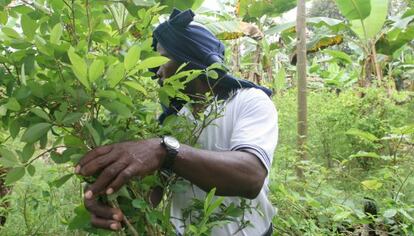Colombia coca production falls by 25%
Cocaine production fell by 10%

Colombia significantly reduced the production of illegal crops in the last year, from 64,000 hectares sown in 2011 to 48,000 in 2012. According to the United Nations Office On Drugs and Crime (UNODC), this number accounts for a 25% decrease.
The UN, whose survey is considered the most reliable analysis of illegal crop production in Colombia, says this drop in coca corresponds to .04% of the total arable land nationwide and that it is the lowest since the Office has been studying the country. The achievement is significant because Colombia has gone from 140,000 harvested hectares in 2001 to 99,000 in 2007, and now it has reduced them to 48,000.
One of the main causes of the reduction in 2012 is due to the government's manual eradication program and its aerial spraying of the crops -- a policy that started with the previous president, Álvaro Uribe. En 2012, between the manual clearing efforts and the sprinklers, they reached 130,000 hectares.
According to the organization, which has been monitoring illegal crops in the country with satellite imaging since 1999, the decrease in at least three provinces is linked to another activity- illegal mining. The UNODC says that coca producers are abandoning this trade to turn to illegal mining, which has become a financial resource for illegal activity. "Sustainability [of the downward trend] will depend on local communities finding viable legal alternatives. " the report says.
The UN has also highlighted the fact that coca cultivation shows up in 20 out of the 23 provinces that traditionally grow the crop. Only three of them - Norte de Santander at the border with Venezuela, Caquetá and Chocó - saw an upturn in production.
The organization concluded that half of coca production is concentrated in three provinces: Nariño, Putumayo, and Norte de Santander, the home of illegal armed organizations such as the FARC and ELN, and other criminal groups such as Rastrojos in the south, the Urabeños and Paisas -- two factions linked to paramilitaries. But in Nariño and Putumayo, which share borders with Ecuador to the south of the country, production has dropped by 10,000 hectares since 2011.
Despite the good news, the UN warns that "the size of the phenomenon in Colombia is still great and requires efforts not only around reduction of the area cultivated with coca but also around improving social, economic and environmental conditions in the affected territories."
This is one of the points that has generated the greatest debate in areas where peasants depend exclusively on the coca crop. In Catatumbo there were demonstrations for nearly two months partly because of the way authorities were eradicating the basic ingredient for the drug while making little progress in the implementation of alternatives.
Cocaine production has also decreased. Colombia has gone from 345 tons of pure cocaine in 2011 to 309 in 2012 - a 10% drop-off.
Authorities confiscated 188 tons, almost 23 tons more than in 2011 when they seized 155 tons.
The UNODC highlighted the fact that areas where the phenomenon has stalled received 234 million dollars in social programs in 2012. And, a good portion of the success of the anti-drug programs depended on "the catch, submissions and neutralization of actors who directly or indirectly served as sponsors in the production and trafficking of drugs," the report says.
According to the survey about 785 metric tons of cocaine are produced worldwide. Colombia, Peru and Bolivia are the largest contributors.
Translation: Dyane Jean François
Tu suscripción se está usando en otro dispositivo
¿Quieres añadir otro usuario a tu suscripción?
Si continúas leyendo en este dispositivo, no se podrá leer en el otro.
FlechaTu suscripción se está usando en otro dispositivo y solo puedes acceder a EL PAÍS desde un dispositivo a la vez.
Si quieres compartir tu cuenta, cambia tu suscripción a la modalidad Premium, así podrás añadir otro usuario. Cada uno accederá con su propia cuenta de email, lo que os permitirá personalizar vuestra experiencia en EL PAÍS.
¿Tienes una suscripción de empresa? Accede aquí para contratar más cuentas.
En el caso de no saber quién está usando tu cuenta, te recomendamos cambiar tu contraseña aquí.
Si decides continuar compartiendo tu cuenta, este mensaje se mostrará en tu dispositivo y en el de la otra persona que está usando tu cuenta de forma indefinida, afectando a tu experiencia de lectura. Puedes consultar aquí los términos y condiciones de la suscripción digital.
Últimas noticias
The complicated life of Francesca Albanese: A rising figure in Italy but barred from every bank by Trump’s sanctions
Pinochet’s victims grapple with José Antonio Kast’s rise in Chile
Reinhard Genzel, Nobel laureate in physics: ‘One-minute videos will never give you the truth’
How Japan is trying to avert ‘digital defeat’
Most viewed
- Pablo Escobar’s hippos: A serious environmental problem, 40 years on
- Reinhard Genzel, Nobel laureate in physics: ‘One-minute videos will never give you the truth’
- Why we lost the habit of sleeping in two segments and how that changed our sense of time
- Charles Dubouloz, mountaineering star, retires at 36 with a farewell tour inspired by Walter Bonatti
- The Florida Keys tourist paradise is besieged by immigration agents: ‘We’ve never seen anything like this’








































